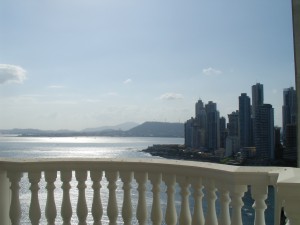
Claremont, CA. On the flight home, I read an issue of Delta Sky Magazine that listed the Panama Canal as one of “70 Wonders of the World.” The canal was listed, along with places like the Golden Gate Bridge and the ickily-nicknamed Chunnel, as one of the world’s great “feats of engineering.”
But during the month we spent in Panama, the canal – despite its dominant presence in the modern imagination – was not the engineering feat most in evidence.
Everywhere in Panama City, there is construction. I was driven into the city on a stretch of land that, a year ago, was not land. Land reclamation seems to be a principal municipal pastime, with spaces for roads and parks and condominiums being carved out of the sea every day. Skyscrapers that seem almost implausibly tall and thin – the structural equivalent of supermodels – are going up everywhere. Although Panama is a premier destination for birdwatching, all the cranes we saw were of the mechanical sort.
Next to all this, the current “megaproject” plan to expand the canal and effectively double its capacity in five years seems like just another thing on the to-do list.
Almost everyone I talked to in Panama City talked about the municipal building frenzy, and almost everyone seemed to look at that building frenzy with a Janus face. One man drove us around the city, lamenting the destruction of his old residential district one minute and imploring us to go shopping in one of the new malls the next. Another person told me that the best part about Panamanian beaches is that many haven’t been developed yet, meaning that they are still as pristine as they were in his youth; five minutes later he spoke admiringly of someone developing a new beach resort. And so on.
In such exchanges, I kept thinking of Marshall Berman’s description of the “tragic struggle,” in All That Is Solid Melts Into Air, that is the modern relationship to home. On the one hand, moderns speak often about a home that is gone and the desire to go back home, “back into our own childhood, back into our society’s historical past”:
“At the same time, modernists do not try to blend or merge themselves with their past – this distinguishes modernism from sentimentalism—but rather to ‘bring it all back’ into the past, that is, to bring to bear on their past the selves they have become in the present, to bring into those old homes visions and values that may clash radically with them – and maybe to re-enact the very tragic struggles that drove them from their homes in the first place.”
“In other words,” Berman writes, “modernism’s rapport with the past, whatever it turns out to be, will not be easy.”
On our last full day in the country, I talked with a local businesswoman who, like so many others, sighed as she talked about the Panama of her youth, and then of the city’s enthusiasm for vertical construction.
“The problem is that people think a new building going up is the same thing as progress,” she said. She paused, then noted that the construction boom has seemed to coincide with an increase in Panama’s already troubling level of income inequality, not to mention what she described as a kind of national existential crisis.
Well, new buildings are a form of progress – a form of progress that is easy to measure and see (and from which it is easy to amass material profit). But, as W.E.B. DuBois pointed out when he described his visit back to the Tennessee village where he had his first teaching job, it’s hard to know what new buildings are worth when their construction seems not to improve – and may even be said to worsen – the lives of people and the land around them. (Think of the canal: It’s easy to see in retrospect that, for all that the Panama Canal has done to change global transit and transportation and commerce, the human and environmental costs of building it were, and may continue to be, substantial.)
The real questions then become: What do we take to be progress, and what should we take to be progress? How should progress be measured, and what do we progress toward? “How many heartfuls of sorrow shall balance a bushel of wheat?” DuBois asks. “And all this life and love and strife and failure,—is it the twilight of nightfall or the flush of some faint-dawning day?”
Today, I’m not sure if there are any social and political questions we bump into with more frequency. They are endemic, and they are inescapable. And I think Berman is right that there is something indelibly tragic about them.
When we got on the plane yesterday, I was glad to escape the Panamanian humidity. The atmosphere is different in southern California – at least in the literal sense. But in the grander scheme the atmosphere here is the same, as it is perhaps everywhere in the modern world, with these questions about what we take to be progress hovering in the air.




4 comments
Hudson
Brooklyn, NY. John Willson: Where did you get the figure of 3,000 deaths related to the Brooklyn Bridge? By one count, 27 men died during construction, including from decompression sickness from working underwater. Other estimates range as high as 40–there is no official figure because of poor record keeping. The Chief Engineer of the project said 20 men died during construction.
Was it worth it? Certainly to many Brooklyn residents at the time it meant a loss of status, perhaps in the way that Staten Islanders feel superior today about their farms and villages. Aesthetically, it’s still one of the best structures in NYC, in my opinion. It has been the inspiration of thousands, if not millions, of works of art, including Hart Crane’s “Bridge” poem.
I have walked across the BB many times. You can see the expansion joints move in and out. According to one account on 9/11, the collapse of the South Tower caused the BB to shake so that the person walking across the bridge feared it would collapse. I walked across it in the ’04 blackout when it was filled end-to-end with pedestrians, and I could feel the span sway.
The bridge combines the old with the new: stone cathedral architecture in the arches with the modern steel suspension cables. I believe that is part of its enduring appeal to New Yorkers and visitors from around the world.
D.W. Sabin
oops, how could i forget…I meant Hoover Institute, maybe he’ll name one of the first Charter Cities “Hooverville”
D.W. Sabin
Some nitwit endowed utopian from that wonderful home of the Heritage Institute, Stanford U….can’t rightly recall his name now, I purged it from the brain folds but he is pushing some madcap idea of “Charter Cities”. In other words, some well-endowed group of supposedly like-minded swells can turn up their noses at existing cities and chose anyplace they want in the whole wide world to create new cities from scratch. He thinks because they are all swell joeys, they will get along and these gleaming new metropoli will be easier to run and can be more environmentally sustainable. I believe he may have suggested the Canadians get together with the Cubans and create a new city at Guantanimo.
We shall think it and voila! Instant City…why be bogged down with those places that already have infrastructure when you can shake and bake a juicy instant town wherever you want? Welcome to Oligarchia where if you have to ask how much it costs to live here, you should stay in Cleveland.
I am only relieved he holds an endowed position …for his sake, not ours.
John Willson
The Brooklyn Bridge cost about 3000 lives. More than 9/11. Was it worth it? It made it possible for Brooklyn to become part of New York City. Was it worth it? The same Teddy Roosevelt who made the Panama Canal a reality came to political maturity as we became an empire. Was it worth it?
Comments are closed.